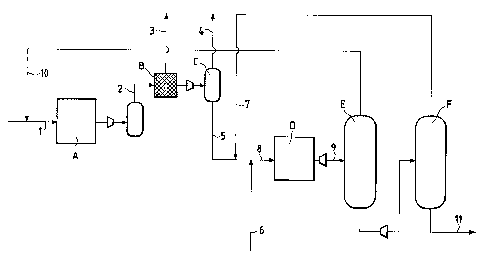Une partie des informations de ce site Web a été fournie par des sources externes. Le gouvernement du Canada n'assume aucune responsabilité concernant la précision, l'actualité ou la fiabilité des informations fournies par les sources externes. Les utilisateurs qui désirent employer cette information devraient consulter directement la source des informations. Le contenu fourni par les sources externes n'est pas assujetti aux exigences sur les langues officielles, la protection des renseignements personnels et l'accessibilité.
L'apparition de différences dans le texte et l'image des Revendications et de l'Abrégé dépend du moment auquel le document est publié. Les textes des Revendications et de l'Abrégé sont affichés :
| (12) Demande de brevet: | (11) CA 2349900 |
|---|---|
| (54) Titre français: | METHODE DE PRODUCTION INTEGREE DU CUMENE |
| (54) Titre anglais: | INTEGRATED PROCESS FOR THE PRODUCTION OF CUMENE |
| Statut: | Réputée abandonnée et au-delà du délai pour le rétablissement - en attente de la réponse à l’avis de communication rejetée |
| (51) Classification internationale des brevets (CIB): |
|
|---|---|
| (72) Inventeurs : |
|
| (73) Titulaires : |
|
| (71) Demandeurs : |
|
| (74) Agent: | ROBIC AGENCE PI S.E.C./ROBIC IP AGENCY LP |
| (74) Co-agent: | |
| (45) Délivré: | |
| (22) Date de dépôt: | 2001-06-07 |
| (41) Mise à la disponibilité du public: | 2001-12-14 |
| Requête d'examen: | 2001-10-04 |
| Licence disponible: | S.O. |
| Cédé au domaine public: | S.O. |
| (25) Langue des documents déposés: | Anglais |
| Traité de coopération en matière de brevets (PCT): | Non |
|---|
| (30) Données de priorité de la demande: | ||||||
|---|---|---|---|---|---|---|
|
Integrated process for the preparation of cumene which com-
prises dehydrogenating a stream of propane to propylene in
a dehydrogenation unit and sending the stream leaving the
dehydrogenation unit, containing 25-40% by weight of pro-
pylene, to an alkylation unit together with a stream of
benzene with a molar ratio benzene/propylene ranging from 8
to l0. The alkylation product is distilled in a first dis-
tillation column to recover a light fraction, essentially
consisting of propane which is recycled to the dehydrogena-
tion, and a heavy fraction which is distilled in a second
distillation column to recover non-reacted benzene at the
head, recycled to the alkylation unit, and cumene with a
purity of over 99%, at the tail.
Note : Les revendications sont présentées dans la langue officielle dans laquelle elles ont été soumises.
Note : Les descriptions sont présentées dans la langue officielle dans laquelle elles ont été soumises.

2024-08-01 : Dans le cadre de la transition vers les Brevets de nouvelle génération (BNG), la base de données sur les brevets canadiens (BDBC) contient désormais un Historique d'événement plus détaillé, qui reproduit le Journal des événements de notre nouvelle solution interne.
Veuillez noter que les événements débutant par « Inactive : » se réfèrent à des événements qui ne sont plus utilisés dans notre nouvelle solution interne.
Pour une meilleure compréhension de l'état de la demande ou brevet qui figure sur cette page, la rubrique Mise en garde , et les descriptions de Brevet , Historique d'événement , Taxes périodiques et Historique des paiements devraient être consultées.
| Description | Date |
|---|---|
| Demande non rétablie avant l'échéance | 2005-06-07 |
| Le délai pour l'annulation est expiré | 2005-06-07 |
| Réputée abandonnée - omission de répondre à un avis sur les taxes pour le maintien en état | 2004-06-07 |
| Modification reçue - modification volontaire | 2003-02-06 |
| Demande publiée (accessible au public) | 2001-12-14 |
| Inactive : Page couverture publiée | 2001-12-13 |
| Lettre envoyée | 2001-11-27 |
| Lettre envoyée | 2001-11-01 |
| Inactive : Transfert individuel | 2001-10-22 |
| Exigences pour une requête d'examen - jugée conforme | 2001-10-04 |
| Toutes les exigences pour l'examen - jugée conforme | 2001-10-04 |
| Requête d'examen reçue | 2001-10-04 |
| Inactive : CIB attribuée | 2001-08-09 |
| Inactive : CIB en 1re position | 2001-08-09 |
| Inactive : Lettre de courtoisie - Preuve | 2001-07-10 |
| Inactive : Certificat de dépôt - Sans RE (Anglais) | 2001-07-09 |
| Demande reçue - nationale ordinaire | 2001-07-09 |
| Date d'abandonnement | Raison | Date de rétablissement |
|---|---|---|
| 2004-06-07 |
Le dernier paiement a été reçu le 2003-05-21
Avis : Si le paiement en totalité n'a pas été reçu au plus tard à la date indiquée, une taxe supplémentaire peut être imposée, soit une des taxes suivantes :
Les taxes sur les brevets sont ajustées au 1er janvier de chaque année. Les montants ci-dessus sont les montants actuels s'ils sont reçus au plus tard le 31 décembre de l'année en cours.
Veuillez vous référer à la page web des
taxes sur les brevets
de l'OPIC pour voir tous les montants actuels des taxes.
| Type de taxes | Anniversaire | Échéance | Date payée |
|---|---|---|---|
| Taxe pour le dépôt - générale | 2001-06-07 | ||
| Requête d'examen - générale | 2001-10-04 | ||
| Enregistrement d'un document | 2001-10-22 | ||
| TM (demande, 2e anniv.) - générale | 02 | 2003-06-09 | 2003-05-21 |
Les titulaires actuels et antérieures au dossier sont affichés en ordre alphabétique.
| Titulaires actuels au dossier |
|---|
| SNAMPROGETTI S.P.A. |
| Titulaires antérieures au dossier |
|---|
| ALBERTO PAGGINI |
| DOMENICO SANFILIPPO |
| ELENA PICCIOTTO |